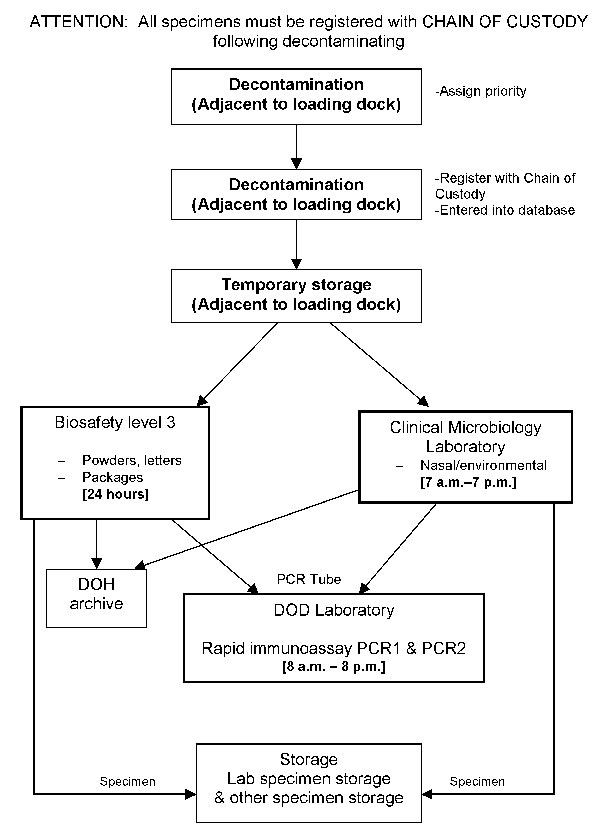Volume 8, Number 10—October 2002
THEME ISSUE
Bioterrorism-related Anthrax
Bioterrorism-related Anthrax
Laboratory Response to Anthrax Bioterrorism, New York City, 2001
Figure 2

Figure 2. Diagrammatic tracking of an environmental sample through the various units and laboratories as it was processed and tested for anthrax at the New York City Bioterrorism Response Laboratory. The first level of the diagram corresponds to the first floor or the sample intake area. Samples were moved via an elevator to the upper floors of the facility, where they were processed and tested. The final destination of all samples was the storage area. Storage was also a locked and guarded forensic evidence room, and samples released from this area after testing negative for Bacillus anthracis were released to the New York Police Department for criminal investigation, return, or disposal.
1 The Joint Microbiological Rapid Response Team consisted of the Biological Defense Research Directorate, Naval Medical Research Center, Bethesda, Maryland: F. Baluyot, M. Boyd, and T. Hudson; 4th Medical Support Squadron, Seymour Johnson Air Force Base, North Carolina, USA: L. M. Bayquen and L. Galloway; and 7th Medical Support Squadron, Dyess Air Force Base, Texas: L. De Los Santos and C. Sekula.
2 The New York City Anthrax Investigation Working Group consisted of Division of Vector-Borne Infectious Diseases, Centers for Disease Control and Prevention (CDC), Fort Collins: May Chu, David Dennis, Kathleen Julian, Anthony A. Marfin, and Lyle Petersen; CDC, Atlanta: Mary Brandt, Richard Kanwal, Kristy Kubota, Els Mathieu, Steve Ostroff, John Painter, Dejana Selenic, Allison Stock, Linda Weigel, and William Wong; New York City Department of Health: Neal Cohen, Laura Mascuch, Denis Nash, Sarah Perl, and Don Weiss; New York City Public Health Laboratories: Alice Agasan, Jay Amurao, Josephine Atamian, Debra Cook, Erica DeBernardo, Adeleh Ebrahimzadeh, Philomena Fleckenstein, Anne Marie Incalicchio, John Kornblum, Ed Lee, William Oleszko, Lynn Paynter, Alexander Ramon, Chiminyan Sathyakumar, Harold Smalls, George Williams, Marie T. Wong, and Ben Y. Zhao.